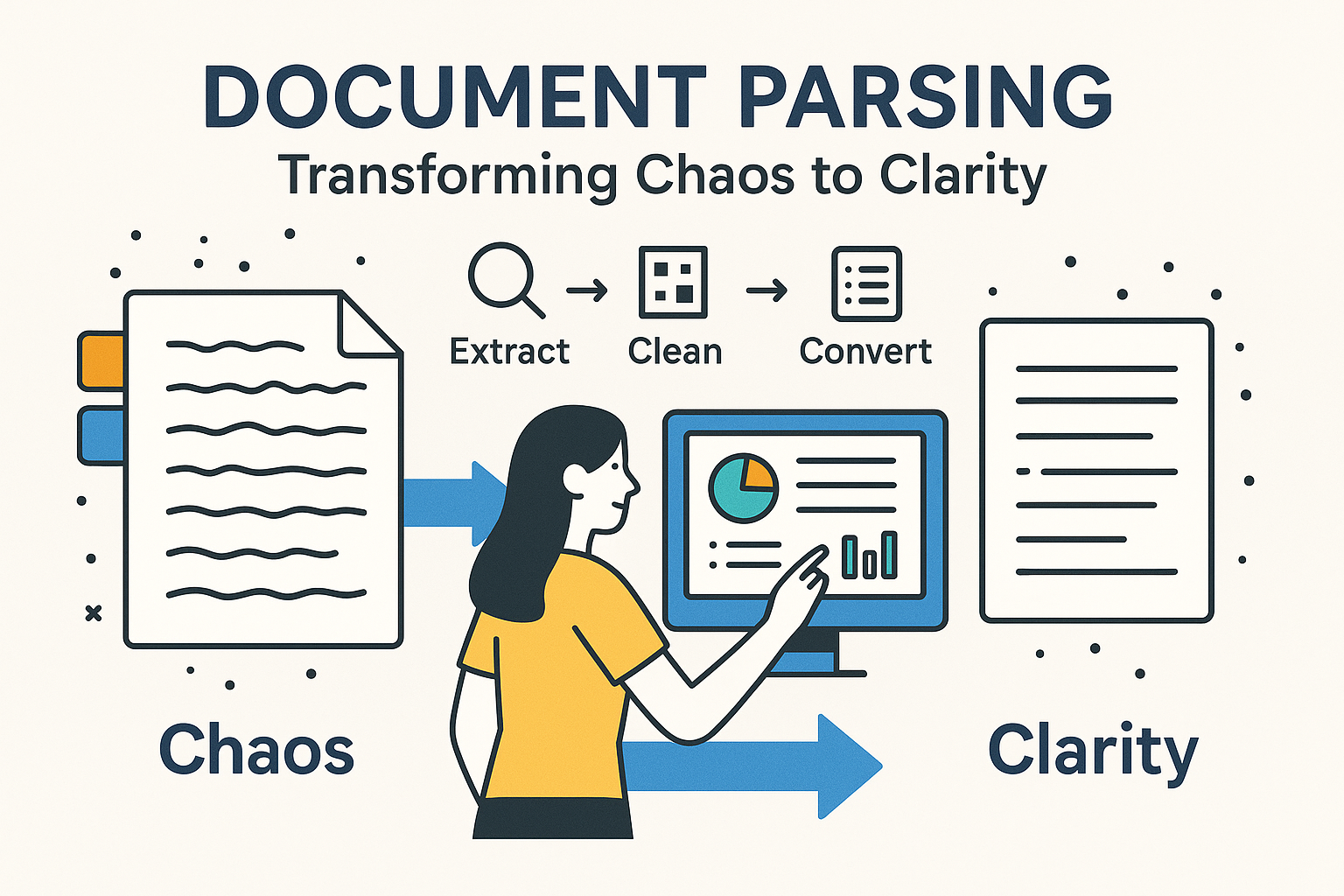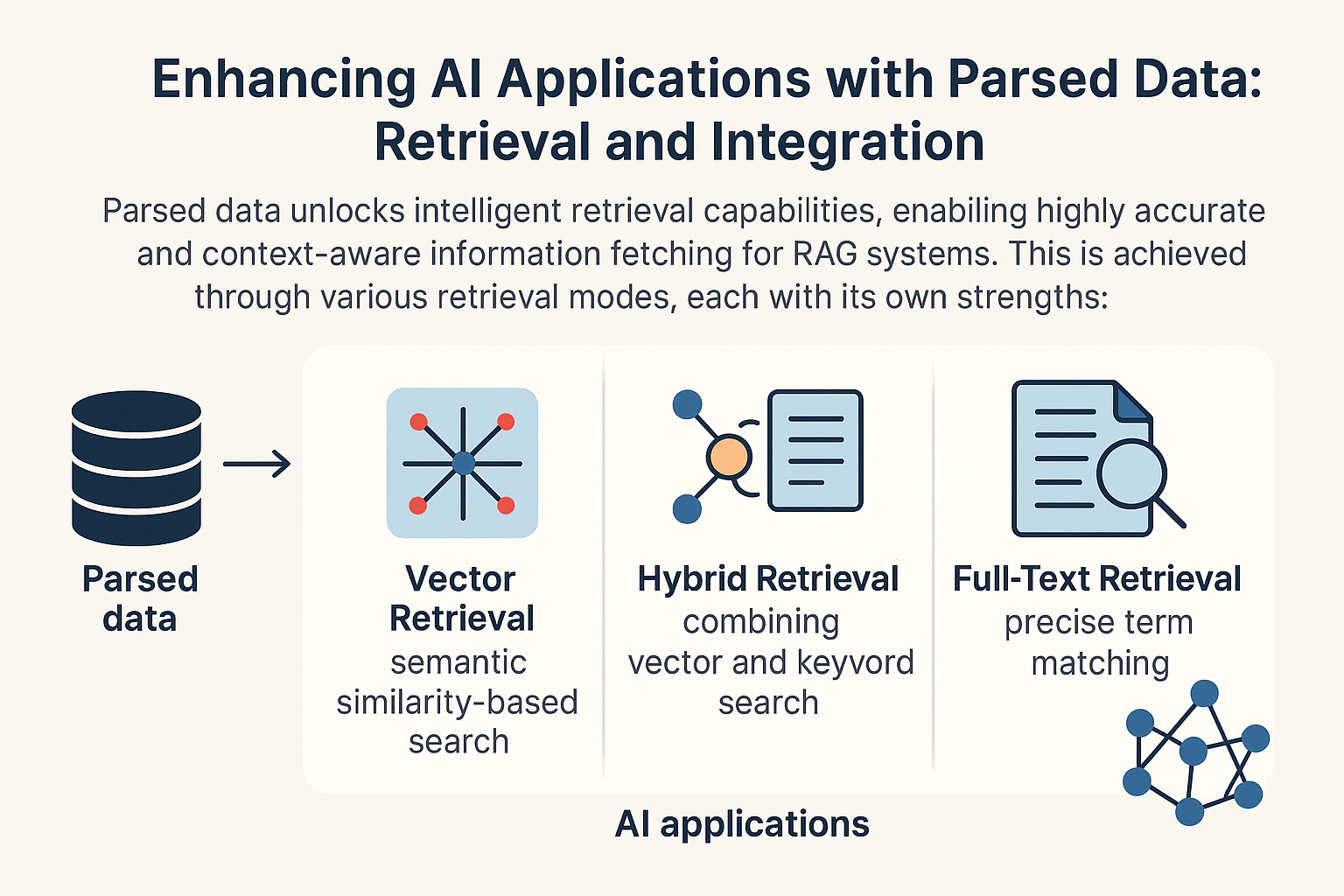Document Parsing for Enhanced AI Applications: Bridging Unstructured Data with Intelligent Systems


Revolutionizing AI with Automated Data Extraction from Unstructured Documents
In the burgeoning field of artificial intelligence, Large Language Models (LLMs) and Retrieval-Augmented Generation (RAG) systems are rapidly changing how we interact with information. However, these powerful tools face a significant hurdle: the vast ocean of valuable information locked away in unstructured documents. These documents, ranging from PDFs and Word files to images and even audio recordings, hold immense potential, but their chaotic nature makes them difficult for AI to process effectively.
 Raw, unstructured data presents numerous challenges for LLMs and RAG. The lack of inherent context, coupled with format variability, can lead to inaccurate outputs and what’s often referred to as “hallucinations” – instances where the AI fabricates information due to the absence of reliable ground truth. This is where document parsing steps in, acting as the foundational layer for building high-quality knowledge bases and ensuring the accuracy, relevance, and contextual understanding of AI applications.
Raw, unstructured data presents numerous challenges for LLMs and RAG. The lack of inherent context, coupled with format variability, can lead to inaccurate outputs and what’s often referred to as “hallucinations” – instances where the AI fabricates information due to the absence of reliable ground truth. This is where document parsing steps in, acting as the foundational layer for building high-quality knowledge bases and ensuring the accuracy, relevance, and contextual understanding of AI applications.
Fortunately, modern tools like ThinkDoc and UndatasIO are democratizing access to advanced document parsing, empowering individuals and developers alike. These platforms bridge the gap between unstructured data and intelligent systems, offering a glimpse into a future where AI can truly understand and leverage the wealth of information hidden within our documents. UndatasIO, in particular, stands out with its ability to transform unstructured data into AI-ready assets, streamlining the development of AI applications.
The Lifecycle of Document Processing in an AI Knowledge Base
Creating a robust AI knowledge base starts with thoughtful planning. The initial setup, including naming conventions and organization principles, is crucial for effective AI utilization. Once the foundation is laid, the next step involves ingesting data from diverse sources. This process can take various forms, each catering to different needs and data types.
Consider the following data input methods: direct file uploads (PDF, Word, PPT, Images) for individual documents, efficient folder imports for batch processing, structured note creation (Markdown support) for annotations, and even web URL import with content scraping to extend data sources to online content. Each of these methods plays a vital role in populating the knowledge base with the raw materials that AI can then process.
Document Parsing: Transforming Chaos to Clarity

At the heart of the document processing lifecycle lies document parsing. Its purpose is to extract critical information, clean the data, and convert unstructured chaos into usable, structured formats suitable for AI consumption. This is achieved through a range of key capabilities, including intelligent document layout recognition, comprehensive extraction of text, tables, images, and formulas, and broad file format support (PDF, DOCX, PPTX, JPG, PNG, HTML, MD, MP3, MP4, M4A). In the case of multimedia files, transcription services convert audio and video content into text, making it accessible for AI analysis.
To optimize results, different parsing modes can be employed. Deep Parsing (Accurate/Multi-modal) offers a thorough analysis that preserves the full document structure and format, including layout, chapter divisions, table structures, image context, headers/footers, and footnotes. While computationally intensive, it yields maximum fidelity, ideal for critical documents where every detail matters. On the other hand, Quick Parsing (Fast) prioritizes speed by focusing on rapid extraction of core textual content, retaining basic paragraph structure and attempting to extract tables/images with some simplification. This mode is perfect for simple documents, bulk processing, or initial content review.
UndatasIO offers both deep and quick parsing modes, ensuring users can optimize for accuracy or speed based on their specific needs. Unlike some alternatives, like unstructured.io and llamaindex parser, UndatasIO is designed to provide a more comprehensive solution for transforming unstructured data into AI-ready assets, focusing on the specific needs of AI application creators and the RAG ecosystem.
The post-parsing output consists of structured data formats (JSON, CSV, Parquet, Markdown, Word, LaTeX) ready for AI consumption, extracted metadata (Name, Author, Abstract, Keywords, Creation Date) crucial for search and organization, and granular content segmentation (text segments, tables, images) for precise retrieval.
Enhancing AI Applications with Parsed Data: Retrieval and Integration
Parsed data unlocks intelligent retrieval capabilities, enabling highly accurate and context-aware information fetching for RAG systems. This is achieved through various retrieval modes, each with its own strengths: Vector Retrieval for semantic similarity-based search, Hybrid Retrieval combining vector and keyword search for nuanced queries, and Full-Text Retrieval for precise term matching. Users can fine-tune retrieval through configurable parameters like TopK results, score thresholds, and re-ranking algorithms to optimize outcomes for specific AI applications.

Seamless API integration is paramount for developers. Robust APIs facilitate programmatic access to upload, parse, and retrieve data, enabling developers to embed these capabilities into their applications.
# Example Python snippet for uploading a file and initiating parsing
import requests
API_KEY = "YOUR_API_KEY"
KB_ID = "YOUR_KNOWLEDGE_BASE_ID"
FILE_PATH = "/path/to/your/document.pdf"
# Upload file
upload_url = f"https://api.example.com/knowledge_bases/{KB_ID}/files" # Replace with actual API endpoint
files = {'file': open(FILE_PATH, 'rb')}
headers = {'Authorization': f'Bearer {API_KEY}'}
response = requests.post(upload_url, files=files, headers=headers)
file_id = response.json()['file_id']
# Initiate parsing
parse_url = f"https://api.example.com/files/{file_id}/parse" # Replace with actual API endpoint
response = requests.post(parse_url, headers=headers)
print(f"Parsing initiated. File ID: {file_id}")
The ecosystem compatibility of these APIs is equally crucial. Easy integration with popular AI platforms and tools like Dify, CherryStudio, Kimi, FastGPT, Discord, Google, Microsoft, and Slack extends functionality and streamlines workflows. UndatasIO is designed for seamless integration, allowing developers to quickly incorporate its powerful parsing capabilities into their existing AI workflows.
Industry-Specific Applications of Advanced Document Parsing
The applications of advanced document parsing span diverse industries. In Manufacturing, Engineering, and Construction, it automates data extraction from mechanical drawings, enabling faster design, cost estimation, and project management. For Accounting, Investment Analysis, and Financial Consulting, it streamlines analysis of financial statements, enabling quicker insights and compliance checks. Law Firms, corporate legal departments, and compliance officers can accelerate document review, e-discovery, contract analysis, and legal research. Even Education benefits through digitizing exam papers, building smart question banks, generating study guides, and automating error logs from student submissions.
The Value Proposition of Leading Document Parsing Platforms (e.g., ThinkDoc, UnDatas.IO)
Platforms like ThinkDoc and UndatasIO offer a compelling value proposition. They guarantee accuracy and ROI, delivering precise data extraction that translates to better AI performance and measurable business benefits. They also offer speed and efficiency, reducing processing times from hours/days to minutes/seconds, freeing up human resources. Robust measures for data security and privacy protect sensitive information during parsing and storage, crucial for compliance.
Furthermore, these platforms offer cost-effective pricing models, with flexible options like Free Tiers for experimentation, tiered Subscriptions, and Pay-As-You-Go with Credit Systems to suit diverse user needs and budgets. A commitment to continuous innovation and feature development ensures they stay ahead with new AI advancements and user-driven improvements. For those seeking to create AI applications, enhance RAG pipelines, or simply unlock the value of unstructured data, UndatasIO offers a powerful and versatile solution.
Conclusion: The Future of AI-Ready Data and Knowledge Management
High-fidelity document parsing is more than just an efficiency tool. It’s a fundamental enabler for building powerful, accurate, and truly intelligent RAG and enterprise AI applications. Platforms like ThinkDoc and UndatasIO empower both individual developers and large organizations to overcome data bottlenecks and create more effective, knowledge-driven AI solutions. UndatasIO specifically empowers users by providing a comprehensive platform to transform unstructured data into AI-ready assets.
Are you ready to unlock the full potential of your unstructured data for AI? Explore the advanced capabilities of platforms like ThinkDoc and UndatasIO today. Visit [ThinkDoc website/ UndatasIO website] to start building your intelligent knowledge base and transform your AI applications! Try UndatasIO Now and experience the difference.
📖See Also
- In-depth Review of Mistral OCR A PDF Parsing Powerhouse Tailored for the AI Era
- Assessment-Unveiled-The-True-Capabilities-of-Fireworks-AI
- Evaluation-of-Chunkrai-Platform-Unraveling-Its-Capabilities-and-Limitations
- Is-SmolDocling-256M-an-OCR-Miracle-or-Just-a-Pretty-Face-An-In-depth-Review-Reveals-All
- Can-Undatasio-Really-Deliver-Superior-PDF-Parsing-Quality-Sample-Based-Evidence-Speaks
Subscribe to Our Newsletter
Get the latest updates and exclusive content delivered straight to your inbox